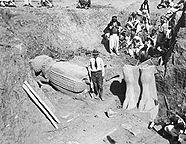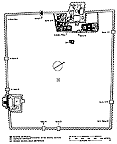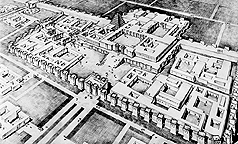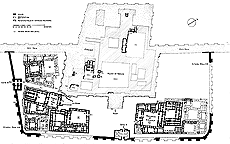
INTRODUCTION
In the early spring of 1920, James Henry Breasted visited the site of Khorsabad, Iraq, for the first time. There he confirmed the impression he had gained from reading French archaeologists' publications of their mid-19th century excavations of the mound - that there was still a great deal of archaeological work to be done in the capital city of King Sargon II (721-705 B.C.). Breasted came away determined that The Oriental Institute would excavate the site.
Some years later, Professor Edward Chiera, newly appointed to the University of Chicago, also visited Khorsabad. On his arrival, the villagers uncovered for him a fragment of relief showing two magnificent horses' heads, thus confirming the presence of treasures lying just beneath the surface.
As a result of these visits, the Oriental Institute obtained a concession for the site and conducted seven seasons of excavation at Khorsabad from 1928 to 1935.
 Khorsabad takes its name from a modern Iraqi village that stands on the ruins of an ancient city called Dur-Sharrukin. Dur-Sharrukin ("Fort Sargon") was constructed as a new capital city by the Assyrian king Sargon II shortly after he came to the throne in 721 B.C. The city had not been completed when Sargon died in 705 B.C. His son and successor, Sennacherib, moved the capital to the old established city of Nineveh, about 15 miles to the south, and Dur-Sharrukin appears to have been largely abandoned.
Khorsabad takes its name from a modern Iraqi village that stands on the ruins of an ancient city called Dur-Sharrukin. Dur-Sharrukin ("Fort Sargon") was constructed as a new capital city by the Assyrian king Sargon II shortly after he came to the throne in 721 B.C. The city had not been completed when Sargon died in 705 B.C. His son and successor, Sennacherib, moved the capital to the old established city of Nineveh, about 15 miles to the south, and Dur-Sharrukin appears to have been largely abandoned.
Because much of Sargon's new capital had never been finished - or perhaps even inhabited - and because it was abandoned in a leisurely manner, there were few small finds discovered during any season. However, Oriental Institute archaeologists uncovered a wealth of information about the architecture of the city. Their work elucidated the construction methods, floor plans, and techniques of architectural decoration of those public buildings that had been the first to be built at the site - the city wall, the palace, the residences of the highest officials of the realm, and the temples of the most important gods.
The work of The Oriental Institute was concentrated primarily in the royal palace and the immediately adjacent area of the city, shown here in a reconstructed view and a plan.
During the first season, the expedition worked primarily within the palace, which had been richly decorated with relief-carved stone slabs. Many of these, including the fragments of a complete human-headed winged bull that once guarded an entrance to the throne room (VII), were donated to The Oriental Institute by the Department of Antiquities of Iraq and installed in The Oriental Institute Museum.
During subsequent seasons, work in the palace continued, leading to the discovery of the throne room (VII) and the identification of the temples of the major Neo-Assyrian gods (around courtyards XXVI, XXVII, XXXI). In addition, careful excavation of the area immediately south and east of Sargon's palace revealed that this part of the city was surrounded by its own wall, forming a kind of citadel with the palace itself. Within this wall, standing on its own platform, was the Nabu Temple, which was surrounded in turn by what must have been the residences of Sargon's highest officials, labeled simply by the excavators "Residences K, L, J, and M." Only the owner of residence L could be identified: Sinahusur, Sargon's brother and grand vizier.
DISCOVERY OF THE ASSYRIAN BULL
Early in April of 1929, workmen excavating outside what would later prove to be the throne room of King Sargon II uncovered fragments of a colossal human-headed winged bull. The sculpture had fallen face downward onto the pavement, had then been covered with the debris of the falling building, and was thus perfectly preserved, although broken into a number of pieces. The expedition's field director, Edward Chiera, was uncertain what to do with this new discovery and immediately cabled Breasted:Breasted promptly cabled Chiera to ask for the piece during the division and to make all necessary arrangements to transport the bull to Chicago, even though he had no money in his budget with which to foot the bill. Pierre Delougaz was placed in charge of the transportation, which proved to be an extremely arduous task.



